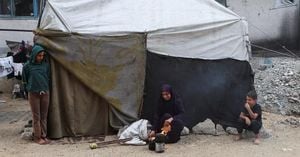It’s been a tense week for Northern California, where two separate fires—one a destructive wildfire, the other a carefully managed blaze—have shaped the landscape and tested the skill of federal land managers. As of September 23, 2025, the Campground Fire in Siskiyou County and the Sunflower 2025 prescribed burn in Tehama County have each been burning for several days, drawing attention to the delicate balance between fire prevention and fire response in the Golden State.
The Campground Fire was first detected at 11:54 a.m. on September 19, 2025, in Siskiyou County, California, according to the National Interagency Fire Center. This wildfire erupted on federal land managed by the United States Forest Service. As of September 23, the fire had been burning for four days, and officials have yet to report any information on its containment. The cause of the Campground Fire remains undetermined, adding a layer of uncertainty and anxiety for residents and officials alike.
Meanwhile, just one county to the south, a very different kind of fire was set intentionally. The Sunflower 2025 prescribed fire was ignited at 8:20 a.m. on September 18, 2025, in Tehama County, California. This project, managed by the Bureau of Land Management, has been burning for five days as of September 23. Unlike the wildfire in Siskiyou County, the Sunflower 2025 burn is a controlled operation—a key tool in the ongoing battle to prevent catastrophic wildfires before they start.
Prescribed fire, sometimes called a prescribed burn or controlled burn, is a wildfire prevention method that involves burning an area of land in a carefully managed way. The aim is to reduce the amount of flammable material—such as dry grasses, brush, and dead trees—that can fuel much larger, more destructive wildfires when the conditions are right (or wrong, depending on your perspective). According to the National Interagency Fire Center, prescribed fires like Sunflower 2025 are designed to minimize the risk of catastrophic wildfires by proactively managing vegetation and restoring healthier, more fire-resilient landscapes.
For many Californians, the juxtaposition of these two fires—one destructive and uncontrolled, the other preventative and deliberate—highlights the complexity of fire management in a state where drought, heat, and changing climate patterns have made wildfire seasons longer and more severe. The Campground Fire’s cause is still unknown, but its very existence serves as a stark reminder of what’s at stake when wildfires break out unexpectedly, threatening communities, wildlife, and precious natural resources.
On the other hand, prescribed burns like Sunflower 2025 demonstrate the proactive steps land managers are taking to prevent such disasters. These burns are not without their challenges or controversy. Some residents worry about smoke, air quality, and the risk of a controlled burn escaping its boundaries. Yet, as fire seasons grow more intense, many scientists and forestry experts argue that prescribed burns are one of the most effective tools available for reducing the fuel loads that make wildfires so devastating.
Federal agencies, including the United States Forest Service and the Bureau of Land Management, have increasingly turned to prescribed burning as part of a broader strategy to restore the health of fire-adapted ecosystems. In places like Tehama County, where the Sunflower 2025 project is underway, these efforts are essential to maintaining the balance between human safety and ecological stewardship.
But while the Sunflower 2025 burn represents a carefully planned intervention, the Campground Fire in Siskiyou County is a sobering example of how quickly things can spiral out of control when fire strikes unexpectedly. As of September 23, 2025, there is still no information on the containment of the Campground Fire, and the cause remains a mystery. The fire’s persistence over four days underscores the challenges faced by firefighters and land managers, especially when dealing with unpredictable weather, difficult terrain, and limited resources.
It’s worth noting that both fires are burning on federal lands, but under the jurisdiction of different agencies. The Campground Fire is on land managed by the United States Forest Service, while the Sunflower 2025 prescribed burn is overseen by the Bureau of Land Management. This distinction matters, as each agency has its own protocols, resources, and priorities when it comes to fire management. Coordination between agencies is crucial, especially when multiple fires are burning in close proximity, as is the case this week in Northern California.
The situation is further complicated by the region’s history with wildfires. Siskiyou and Tehama counties have both experienced devastating fires in recent years, leading to greater awareness of the need for both rapid response and long-term prevention strategies. The ongoing Campground Fire has residents and officials on edge, hoping for swift containment and minimal damage. At the same time, the Sunflower 2025 project is a reminder that not all fire is bad; when used wisely, fire can actually help protect both people and the environment from even greater harm down the line.
As of now, details about the Campground Fire’s size, impact, and progress toward containment remain scarce. The lack of information has fueled anxiety among those living nearby, who are all too familiar with the speed at which wildfires can spread. Local news outlets and the National Interagency Fire Center continue to monitor the situation closely, providing updates as they become available.
For the Sunflower 2025 burn, the story is one of careful planning and execution. Prescribed burns are typically conducted under specific weather conditions—when humidity is higher, winds are low, and the risk of escape is minimized. Crews monitor the burn constantly, ready to intervene if conditions change. The goal is to achieve ecological benefits while keeping people and property safe. In this case, the Bureau of Land Management’s efforts have so far gone according to plan, with the prescribed fire burning as intended for five days.
As California heads deeper into another fire season, the lessons from Siskiyou and Tehama counties are clear: wildfires remain a constant threat, but proactive measures like prescribed burns can play a vital role in reducing that threat. The challenge lies in balancing immediate response with long-term prevention, and in communicating the reasons behind each approach to a public that is understandably wary of both smoke and flames, regardless of their origin.
For now, all eyes remain on the Campground Fire’s progress and the outcome of the Sunflower 2025 project. The coming days will reveal whether containment efforts succeed and whether prescribed burning continues to prove its worth as a critical tool in California’s fight against wildfire.



